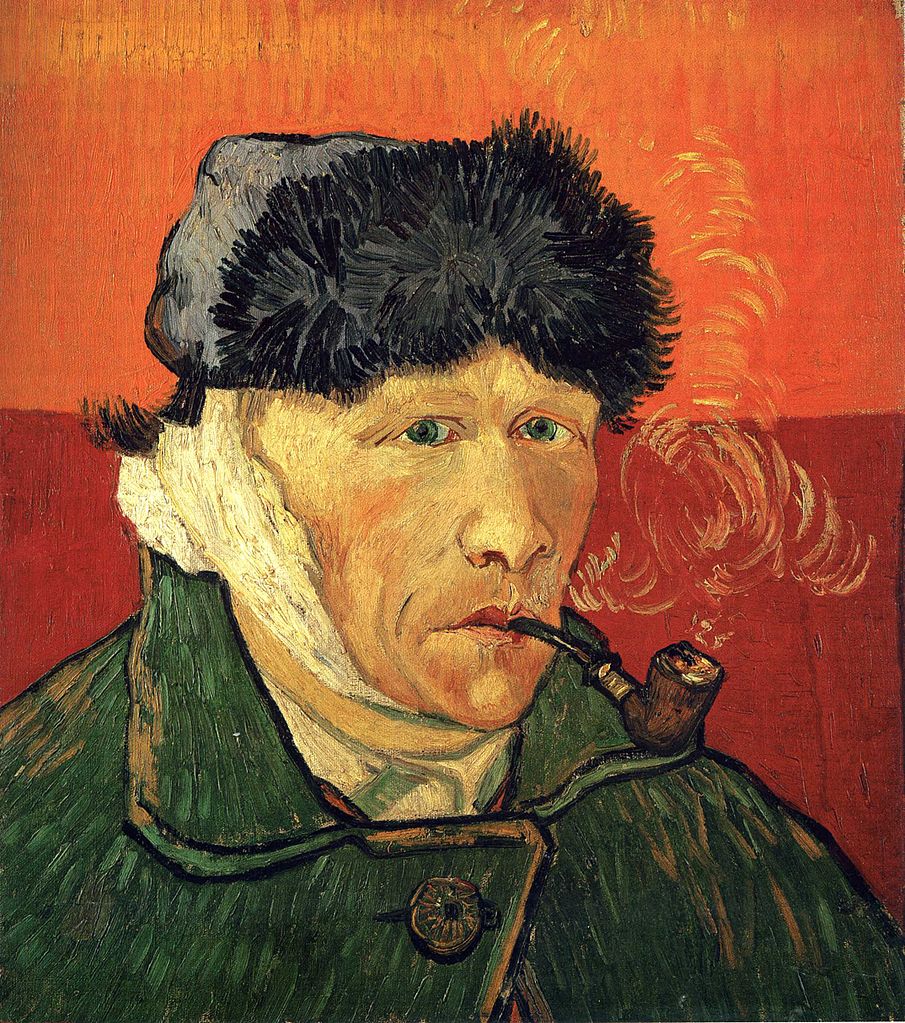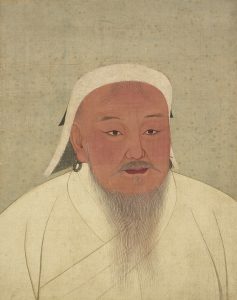Vincent Van Gogh was an admired artist, who was also a troubled and “tortured genius.” His artwork, Starry Night, Bedroom in Arles, and many others have earned him fame and recognition as one of the greatest artists of his time. But what many remember most about this artist is the story of his severed ear. Although his art is exemplary, his struggle with mental health and self-harm is admirable. His struggle was overlooked due to his incredible talent. He was successful as an art dealer, but as an artist, he had to prove himself with the headquarters of international art dealers, Gopil & Cie. During his lifetime, Van Gogh was the poster boy for the image of starving artist. His artwork was not recognized until much later in his career, which could have been a leading cause of his major depression and anxiety.1
Van Gogh, born in the Netherlands, decided to start his career in Paris in the 1880s, where many of the age’s great artists also resided. He believed he could get recognition for his pieces through his younger brother, Theo, who made his living as an art dealer. His brother introduced him to many artists, including Georges Seaurat, Camille Pisatto, and Paul Gauguin. Upon meeting these successful artists, Van Gogh was greatly inspired by their work and began creating his own artistic style, beginning in 1883. Later the same year, Van Gogh rented a small house in Arles, in the south of France. Paul Gauguin and Van Gogh became close friends and later roommates. They consistently bounced ideas off of each other and created a strong friendship.2

Like many friendships, theirs was rocky, and they found themselves drifting apart. Gauguin had moved on to a different artistic style and was exploring other ideas. Van Gogh at the time, had been reciprocating signs of depression and mental health issues, but at the time, these symptoms were considered normal. When Gauguin decided to explore other art spectrums, it involved moving out of the house he and Van Gogh shared. He broke the news to his roommate about his intentions, and this evidently this made Van Gogh go over the edge. He did not take the news lightly and both men began verbally arguing. Van Gogh had disappeared for a few hours and when he returned to confront Gauguin, he had a razor blade in hand threatening to hurt Gauguin.3
During the confrontation, however, Van Gogh was hesitant to hurt his friend and decided to turn the blade on himself and completely cut off his ear. Gauguin left him bleeding and alone. Van Gogh bandaged his head and began drowning himself in alcohol. During this episode, he walked out of his home and into the streets where he found a prostitute. The ear that he had severed off of himself had been neatly wrapped in a cloth; since Van Gogh was still heavily intoxicated, he decided to present this token to the prostitute. Patiently, she ran off and alerted the police about her encounter and they immediately rushed to his home.4
Shortly before Christmas Eve, Van Gogh was found by police in his bed, partially conscious and with major blood loss. Authorities rushed him to the hospital where he surprisingly recovered. Meanwhile, Gauguin was brought into questioning, but gave no testimony on the incident. It was believed that Van Gogh had suffered a severe mental breakdown long before he had severed his ear, but that this created a ripple effect that led to lunacy. The real reason behind the infamous Van Gogh ear-cutting may never be known; Gauguin had promised Van Gogh a pact of silence on the situation in letters that they supposedly exchanged. 5

After the incident, Van Gogh was admitted into a psychiatric facility in hopes of recovering mentally and physically. The dramatic change was not helpful for such a troubled artist, and in July of 1890, Vincent Van Gogh ended his life with a revolver. Before his suicide, however, he created a very iconic painting, Self Portrait with Bandaged Ear 1889. Van Gogh intended to persuade his doctors that he was perfectly able to continue working and creating art by creating this self portrait. He presented his piece, leaving a trail of wonder for his supporters as to why he included certain details in this particular piece, mainly because he continued to paint himself in the same yellow house he and Gauguin shared. Doctors overlooked these details and allowed Van Gogh to leave the facility.6
The epidemy of many artists like Van Gogh is often associated with mental instability, drug use, and alcohol abuse. Van Gogh had an array of medical issues that were tied back to his coping mechanisms (alcohol abuse), and as a result, many did not understand the struggles he faced and degraded him as a person while idolizing his artistic talent. As said before, the real reason behind his mutilated ear will be unclear, but his work and talent will continue to inspire and educate.
- Adam Gopnik, “Van Gogh’s Ear,” The New Yorker, Literature Resource Center (January 4, 2010): 48. ↵
- “Who Really Cut Off Van Gogh’s Ear?” Weekend All Things Considered, Literature Resource Center, (May 2010). ↵
- “Who Really Cut Off Van Gogh’s Ear?” Weekend All Things Considered, Literature Resource Center, (May 2010). ↵
- Belinda Thomson, “Comparing lives: issues of balance in biographical writing,” Literature Resource Center, French Politics, Culture and Society 24, no. 2 (2006): 60. ↵
- Tim Suermondt, “All the Answers.” Literature Resource Ceter, Prairie Schooner 85, no.3 (2011): 47. ↵
- Tim Suermondt, “All the Answers,” Literature Resource Center, Prairie Schooner 85, no. 3 (2011): 47. ↵



170 comments
Madeline Chandler
This is such a well written engaging article. An extremely captivating and informative article. I knew Van Gogh’s story in part however not this in depth. It is so devastating that such a well known, truly amazing artist had such dire mental health issues. It shows his audience that even though one can be so successful it doesn’t guarantee happiness. Even though his story is heart breaking, the world is so blessed to have witnesses his works. Job well done! Thoroughly enjoyed it!
Nathan Castillo
I love Van Gogh’s work, but I have never heard the reason why he cut off his ear. I have been told before that Van Gogh did cut off his ear, but it was for a different reason, but as you said, the story is to too clear. I feel like that if Van Gogh was properly taken care and paid more attention to with mental disabilities as they do today, I am sure that Van Gogh would have continued to make more beautiful artwork. Tragic.
Kayla Mendez
Mental illness is often glamorized, especially in today’s culture. Unarguably, Van Gogh’s art held beauty, but it also displayed his inner battles. People forget that mental illness can bring actual danger to people’s lives. Unfortunately, Van Gogh experienced the extremity of his mental illness. What I find the saddest is that he continued to paint in the setting of his shared home with Gauguin, expressing his feelings toward their friendship. In the end, I believe they both cherished their bond, for Gauguin kept his promise of silence even after the passing of his friend.
Matthew Fabela
Mental health during this time wasn’t taken as seriously as it is today, not that it’s fully taken seriously today either but we have definitely progressed since the 1800s. Van Gogh is one of my favorite artists and I feel if he were to have been properly assessed and treated with today’s knowledge of mental health he would have gone on to create so much more artwork
Alexandria Wicker
I’ve never really known a lot about Van Gogh so I found this article very informative. It is crazy to think that his mental health was pushed aside because of his fame and his success. Mental health issues can be placed upon anyone, even people with big successes. The story of him cutting off his ear is quite crazy. That is something I have never heard of and it really comes to show us that people are fighting so many personal battles that we would never know about.
Elizabeth Santos
Van Gogh’s story is heartbreaking, but I’m glad I was able to get educated on his battle with mental illness. The artist is known for his amazing artworks and his severed ear, but it seems that that’s the only information really portrayed along with his popularity across different social media platforms that seem to romanticize his illnesses. I appreciate the part on how Van Gogh was influenced by different artists to create his unique art style. This article is very informative and surely pulls at everyone’s heartstrings!
Kendall Guajardo
It is really sad to hear that a lot of people in creative professions are often the most depressed. I knew of his mental instability but not so much into the background of him cutting off his ear. Very talented he was but that did not matter when he really had no one to ground him. Perhaps he may have been talented but his self perception was completely warped and caused him to have really bad attachment issues. I would really love to know what came of him and his friend later on. I feel that this was a great example of the tragedies of mental illness. Great article!
Melissa Garza
I absoluetly loved reading this article about Vincent Van Gogh, I have heard of his mental illness and his severed ear but it was really interesting to get more into art career despite his illness and constant depression. I was unaware that he had to be admitted to a psychiatric ward because of his severed ear. His art is so beautiful and it just goes to show that his passion was so strong. What a great read Alondra!
Alondra Lozano
This was a really interesting article. The question of why Van Gogh severed his ear never came across my mind and it was really interesting to know about his illness too. It’s pretty sad to know that a lot of great artists and musicians suffer from depression and mental illnesses. He did some amazing work and I wonder what really happened with him and Gauguin.
Juliana Montoya
Vincent Van Gogh was a very talented artist and many of his pieces are displayed all over the world because of his amazing work. I had never known about his mental illness and the fact that he was admitted into a psychiatric ward when he had cut off his ear. The saddest part about the article is the fact he was always so depressed.